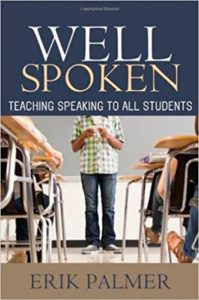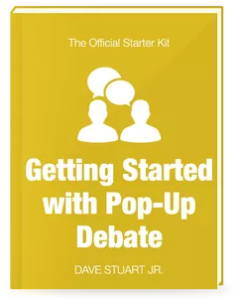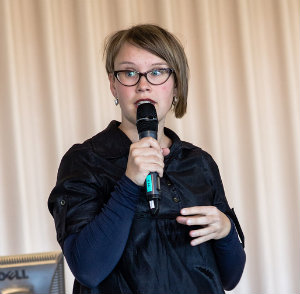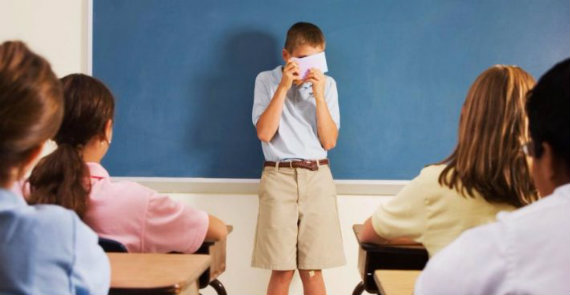Helping Students Speak More Effectively in Class
A MiddleWeb Blog
 We all want our students in the middle grades to contribute more to class. We want them to do more of the talking.
We all want our students in the middle grades to contribute more to class. We want them to do more of the talking.
We know from our own experience as teachers that when we have to present something, we are more likely to internalize it and learn it better than when we are only listening.
But getting more students to participate is easier said than done, right? Take, for example, a typical student presentation. We’ve all been there:
Carly: So, our presentation is about the Battle of Saratoga. The Battle of Saratoga was fought . . . . It was, like, really important. (Voice lowered, turns to Jenna). Jenna, do you have the page on the significance?
Jenna: No, Alexis has it. (Alexis is absent).
Carly: Okay, so Alexis was supposed to do this part. . . . But the reason, like, the uh, Battle of Saratoga was so important was because of the French.
Jenna: Yeah, after Saratoga the French decided they would help the Americans out.
Carly: With money and stuff.
And what isn’t revealed in the script above? The “upspeak” at the end of sentences. The kid in the back doing his math homework because this presentation is so boring. And you, the teacher who assigned this, trying to stay awake and look enthusiastic.
Help from Erik Palmer
Ever since I read the work of consultant and former teacher Erik Palmer on public speaking (see this article and this one that he wrote for MiddleWeb), I have been smitten by the idea of having my students do more presentations. But I haven’t gotten there. Yet.

Getting better involves two major components, according to Palmer in his book, Well Spoken: Teaching Speaking to All Students. The first is building a speech and includes consideration of audience, content, organization, visual aids and even how students will dress. The second is learning how to perform a speech, which involves what Palmer has coined, “PVLEGS”– poise, voice, life, eye contact, gestures and speed. (Again check out the MiddleWeb links above to read more about these).
Last year, I introduced Palmer’s PVLEGS to students. We spent some class time (several Fridays in December seemed to be a good window) working on speaking skills. One of those days I played a brief TED Talk from the comedian Will Stephen which was an amusing way to highlight good speaking skills.
We also did some exercises from Erik Palmer’s website. These are wonderfully engaging activities and fun for students.
I did these activities fully intending to assign students to create a full-blown speech later in the year. But I don’t have to tell you what happens to the best of intentions. Unfortunately, the Big Speech assignment never happened.
The value of mini-speeches
But just as students need to learn to write good sentences and paragraphs before they can write a good paper, students need practice with speaking long before they are ready to stand up and give a full-fledged speech. So one of the things I was able to do this past year was to give students more opportunities to give “mini-speeches.”

Essentially, it’s a technique in which all students are required to speak during a class period about a particular topic by “popping up” (standing) and making a statement. Check out Dave Stuart Jr.’s overview of the pop-up debate and read more in his archive. It is a technique that is endlessly adaptable. And really easy to implement.
One time I used it was during a discussion about the goals of Booker T. Washington and W.E.B. Du Bois. After a couple of days spent reading from the writings of Washington and Du Bois, students had to express their view on which man had the better approach to improving the lives of African Americans during the Progressive Era. This topic worked well both because of the interest students had in the topic, and also because there was an actual debate: two different viewpoints.
How I manage lots of speeches during a class
I have my seating chart handy and check students off as they speak. I keep one eye on the clock and issue reminders: “We have 15 minutes left and there are still 6 of you I’d love hear from.” Usually, this is all students need to get them up and speaking. To my surprise and delight, I also found students positively offering support to each other. Many seemed to have the attitude, “hey, if I had to do this, then everyone else in the class has to.” But the peer pressure was positive.
Are these mini-speeches graded?

The problem of repetitiveness
One flaw with this technique, depending on the topic and the size of the class, is that at a certain point, most viewpoints have been stated. For these occasions, it is important to have what I call “wrinkles.” After most of the major points have been made, I might throw in a “wrinkle” – a variation of the question, or another piece of information.
For example, if the original discussion had students debating the merits of Washington and Du Bois, I might throw in the “wrinkle” of who is more conservative? When does it make sense to be more conservative and compromise? When does it make sense to be more resistant?
In this instance, I reminded students of an earlier discussion we had on the merits of Carrie Chapman Catt’s and Alice Paul’s differing approaches to women’s suffrage. This created opportunities for students to “pop-up” and offer new insights. If you don’t “wrinkle,” you will find students saying things like, “I agree with what [earlier student] said because [and now repeat what that earlier student said].”
What about kids who REALLY hate public speaking?
Fear of speaking is not an easy issue to address. But I learned five key things about this:
- Nothing I do in my classroom ever has a 100% success rate.
- Some of the students who most hated this technique were the most proud of themselves when they realized it really wasn’t that bad to get up and say something in front of the class.
- We don’t allow students to “opt out” of taking tests, writing papers or doing homework. So why should we let them opt out of speaking?
- Despite number 3 above, there were several times when I did let students “opt out.” I had a few students who had some tough emotional issues, and it wouldn’t have been appropriate to force the issue. Obviously, it is important to use good judgment about this.
- Despite number 4 above, even those few students – five of them out of 110 – participated in a pop-up debate at some point over the school year. Every single one of them. So maybe there is such a thing as 100% success!
So I urge you, this year, give pop-up debates a try in your classroom. And if you have already discovered this technique for yourself, let me know how you adapted it.



































Lauren, loved the Ted Talk and book, website, and blog suggestions. I’m glad there is new writing on this topic. Pop-up debate sounds like a lot of fun. Thanks for this terrific article.
Fantastic!! Thanks for the mention and thanks for valuing the #1 language art, speaking. The practical tips you offer will help other teachers, for sure. Your students will benefit for all time. Well played!
Thanks, Erik!
Mary and Erik, thanks so much for your comments. Mary, do check out Erik Palmer’s website and Dave Stuart’s stuff. They really inspired me. And my students (mostly) really liked it. And even the ones who hated it, did it and survived.
And, fyi, on the 2nd day of class this year, I had all the students in a big circle discussing quotations about the importance of history. I said that every student had to speak. And they all did (except for 1 with some anxiety, and 1 or 2 in my biggest class, where I just didn’t keep close enough tabs.) But the expectation has been set!
Lauren, your suggestions are excellent! I have used the PVLEGS acronym ever since I read Erik’s book, and I look forward to trying pop-up debates. Thanks for all these ideas.
Thanks, Sarah. I love the PVLEGS acronym too. And I love it when kids who hate speaking in class speak in class and come out of it feeling so much more confident.